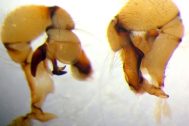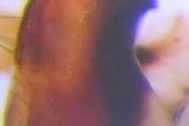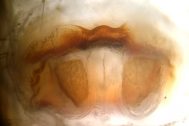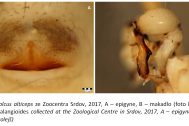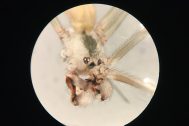| Records by time | |||||
|---|---|---|---|---|---|
| Pholcidae | 0-1900 | 1901-1950 | 1951-2000 | 2001+ | ∑ |
| Pholcus alticeps Spassky, 1932 | 9× | 9× | |||
Pholcus alticeps Spassky, 1932
| Czech name | třesavka vysokohlavá |
|---|---|
| Records | 9 nálezů, 6 kvadrátů |
| Last record | 2022 , Kryštof Rückl, Viktor Střeštík |
| Description | Pholcus alticeps je na první pohled nekontrastní zmenšeninou P. phalangioides. Velikostí je tento druh mezi P. phalangioides a P. opilionoides (Schrank, 1781), skvrnu na hlavohrudi má podobnou spíš P. phalangioides, avšak nevýraznou, jakoby do stran se rozplývající do ztracena. Na genitáliích jsou výrazné znaky, samičí epigyne je u P. phalangioides výrazně širší než dlouhá. |
| Phytogeographic area | - |
| Původnost stanovišť | - |
| Humidity | - |
| Stratum | - |
| Osvětlení stanovišť | - |
| Hojnost výskytu |
|
| Altitude | 150-600 |
Bibliography
Pavouk 58 (07/2025)
Pavoukovci České republiky; Záhadná firemní skálovka; Vzácné druhy listovníků v Miloticích; Nález snovačky Enoplognatha mordax (Theridiidae) v Podkrušnohoří a plachetnatky Porrhomma campbelli (Linyphiidae) v Krušných horách; Výskyt skákavky Philaeus chrysops (Salticidae) mimo přírodní stanoviště; Pár poznatků o výskytu a biologii snovačky Dipoena torva v Železných horách; Meta menardi neboli křižák temnostní: experimentální vhled do ekologické tolerance pavouka temnot; Štíři jako hostitelé larev roztočů; Výskyt pavouků v zimním období, včetně skákavky Sibianor larae (Salticidae) a třesavky Pholcus alticeps (Pholcidae); Vzpomínka na Rudu Macka; Pavouci ve školce vítáni; Zoologické dny Brno 2025; Arachnologická exkurze 2025 – Pobečví; Česká bibliografieInventarizační průzkumy 2024; Pokyny pro autory
Výskyt pavouků v zimním období, včetně skákavky Sibianor larae (Salticidae) a třesavky Pholcus alticeps (Pholcidae). Occurrence of spiders in winter, including the jumping spider Sibianor larae (Salticidae) and the daddy long-legs spider Pholcus alticeps (Pholcidae). Pavouk 58: 17–18 (in Czech)
This is probably the first documented occurrence of the species Sibianor larae Logunov, 2001 in winter. Observation of the species Pholcus alticeps Spassky, 1932, reveal its activity at low temperatures.Pavouk 57 (12/2024)
Pavoukovci České republiky; Misumena bicolor pod Radhoštěm – mysteriózní běžník poprvé zastižen v Česku; Běžník Kempelenův (Xysticus kempeleni) po 17 letech v Čechách; Zápřednice karmínová Cheiracanthium montanum je stále součástí arachnofauny Čech; Nové přírůstky do checklistu Krušných hor, Podkrušnohoří a Doupovských hor; Ošidná determinace; Pholcus alticeps – poznámka k výskytu mimo vnitřní prostory; Zajímavé nálezy sekáčů aneb jak občanská věda pomáhá našim opilionologům; Druhý nález sekáče Leiobunum sp. A; Pavoučí vlákno; Rozhovor s Frantou Šťáhlavským; Ohlédnutí za 35. Evropským arachnologickým kongresem v Rennes; (Nejen) arachnologické exkurze pro veřejnost v roce 2024; 121. arachnologický seminář v Pardubicích; Česká bibliografie; Nové knihy; Pokyny pro autoryPholcus alticeps – poznámka k výskytu mimo vnitřní prostory
Observation of this species in several places outside the indoor spaces is documented and the possibility of colonization in free nature is discussed.Pavouk 55 (12/2023)
Pavouci České republiky; Populace vzokana vlasatého (Ischnothyreus velox, Araneae: Oonopidae) v České republice; Sametkovci (Acari: Prostigmata) ČR, aneb ne všechny sametky jsou stejné; Je Carniella brignolii (Araneae: Theridiidae) z Rumunska jiná?; Překvapení z překvapení; Pholcus alticeps ve volné přírodě; Život na spáleništi; Paralyzace pavouků; 120. seminář České arachnologické společnosti; Izrael – za pět minut dvanáct; Česká bibliografie; Nové knihy; Pokyny pro autoryPholcus alticeps ve volné přírodě
Two records of Pholcus alticeps species outside the interior spaces of buildings are presented here.Karyotype differentiation and male meiosis in European clades of the spider genus Pholcus (Araneae, Pholcidae).
Haplogyne araneomorphs are a diverse spider clade. Their karyotypes are usually predominated by biarmed (i.e., metacentric and submetacentric) chromosomes and have a specific sex chromosome system, X1X2Y. These features are probably ancestral for haplogynes. Nucleolus organizer regions (NORs) spread frequently from autosomes to sex chromosomes in these spiders. This study focuses on pholcids (Pholcidae), a highly diverse haplogyne family. Despite considerable recent progress in pholcid cytogenetics, knowledge on many clades remains insufficient including the most species-rich pholcid genus, Pholcus Walckenaer, 1805. To characterize the karyotype differentiation of Pholcus in Europe, we compared karyotypes, sex chromosomes, NORs, and male meiosis of seven species [Pholcus alticeps Spassky, 1932; P. creticus Senglet, 1971; P. dentatus Wunderlich, 1995; P. fuerteventurensis Wunderlich, 1992; Pholcus phalangioides (Fuesslin, 1775); Pholcus opilionoides (Schrank, 1781); P. silvai Wunderlich, 1995] representing the dominant species groups in this region. The species studied show several features ancestral for Pholcus, namely the 2n♂ = 25, the X1X2Y system, and a karyotype predominated by biarmed chromosomes. Most taxa have a large acrocentric NOR-bearing pair, which evolved from a biarmed pair by a pericentric inversion. In some lineages, the acrocentric pair reverted to biarmed. Closely related species often differ in the morphology of some chromosome pairs, probably resulting from pericentric inversions and/or translocations. Such rearrangements have been implicated in the formation of reproductive barriers. While the X1 and Y chromosomes retain their ancestral metacentric morphology, the X2 chromosome shows a derived (acrocentric or subtelocentric) morphology. Pairing of this element is usually modified during male meiosis. NOR patterns are very diverse. The ancestral karyotype of Pholcus contained five or six terminal NORs including three X chromosome-linked loci. The number of NORs has been frequently reduced during evolution. In the Macaronesian clade, there is only a single NOR-bearing pair. Sex chromosome-linked NORs are lost in Madeiran species and in P. creticus. Our study revealed two cytotypes in the synanthropic species Pholcus phalangioides (Madeiran and Czech), which differ by their NOR pattern and chromosome morphology. In the Czech cytotype, the large acrocentric pair was transformed into a biarmed pair by pericentric inversion.
Významné nálezy pavouků od Nových Mlýnů aneb najde ten, kdo nehledá
During the ethological research of Larinia elegans on Nové Mlýny dam in South Moravia, several spiders were collected, among which we highlight rare philodromids associated with wet biotopes, Philodromus poecilus and Philodromus marmoratus. Theridion familiare was caught in a mobile home near the dam, which is the first record for Czechia.Pavouk 44 (6/2018)
Pavouci České republiky; Druhy rodu Dysdera (Dysderidae) v Česku; Pholcus alticeps na severozápadě České republiky; Díky osobnímu automobilu; Výprava za stepníky a teplomilnými křižáky na jižní Moravu; Významné nálezy pavouků z ČR IV. / Remarkable records of spiders from Czechia IV.; Inventarizace 2017; Hrabalky (Pompilidae) – specialisté na lov pavouků II: rod Cryptocheilus; Jak dlouho vydrží Dolomedes pod vodou?; Rozloučení se Zdeňkem; Říkali jsme mu „haldový expert“; Zoologické dny Praha 2018; Arachnologická exkurze Litovelské Pomoraví; Česká bibliografie 2018; Britská bibliografie – The Newsletter 140 a 141; Pokyny pro autoryPavouk 42 (7/2017)
Pavouci České republiky; Nový druh třesavky pro území České republiky, aneb další synantrop za dveřmi (nebo před?); Zajímavý nález tropické maloočky v Hranicích na Moravě; Katalogy pavouků a evidence prvonálezů; Snovačka půdní (Steatoda triangulosa) ve volné přírodě v ČR; Poznámka k výskytu listovníků Philodromus margaritatus a P. fuscomarginatus; Nová lokalita sklípkánka hnědého (Atypus affinis); Zoologické dny Brno 2017; Česko-britský arachnologický seminář v Praze; Exkurze Mohelenský mlýn 2017; Arachnologická exkurze Mostecko 2017; Přírodovědecký spolek Arachne; Obsah původního Arachnologického spravodaje v minulosti; Čestní členové České arachnologické společnosti; Arachnologická knihovna Jiřího Bauma; Česká bibliografie 2017; Britská bibliografie – The Newsletter 138; Inventarizace 2016; Pokyny pro autoryGallery
Statistics
By month
By altitude
By collecting method (9 used records)
| Pholcus alticeps Spassky, 1932 | Males | Females | Juveniles | Records |
|---|---|---|---|---|
| Individuální sběr | 8 | 9 | 2 | 9 |
| Males | Females | Juveniles | Records |
By biotope (9 used records)
| Pholcus alticeps Spassky, 1932 | Males | Females | Juveniles | Records |
|---|---|---|---|---|
| Interiéry budov | 8 | 9 | 2 | 9 |
| Males | Females | Juveniles | Records |






